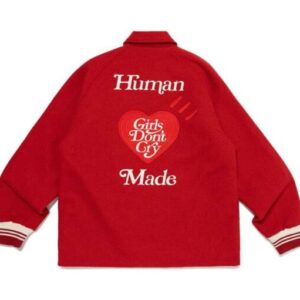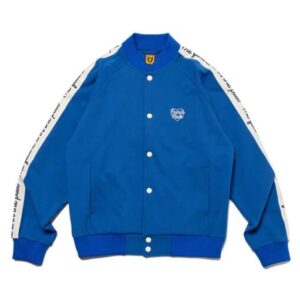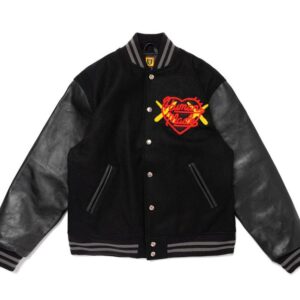
Human Made Girls Don’t Cry Jacket Dark Green
Original price was: $430.00.$299.00Current price is: $299.00.
Human Made Girls Don’t Cry Jacket Red
Original price was: $430.00.$299.00Current price is: $299.00.
Human Made Track Jacket Black
Original price was: $430.00.$299.00Current price is: $299.00.
Human Made Track Jacket Blue
Original price was: $430.00.$299.00Current price is: $299.00.
Human Made Varsity Jacket Black
Original price was: $430.00.$299.00Current price is: $299.00.Human-Made Jackets:
Human-made jackets have become a prominent trend in the fashion industry, combining creative design with ecological concern. Human-Made Jackets comprised of synthetic and recycled materials, provide a fashionable yet environmentally friendly substitute for traditional options as customers grow more conscious of the effects that their clothing choices have on the environment. The many aspects of jackets manufactured by humans are examined in this article, including their benefits and materials as well as their styles and potential future uses.
The Rise of Human-Made Materials:
Wool, leather, and cotton were among the natural materials used to make jackets in the past. Although these materials were valued for their comfort and toughness, they frequently had a large environmental cost. Natural fiber manufacturing has the potential to cause enormous water use, pesticide use, and deforestation. However, the move toward fabrics produced of human material is part of a larger trend in the fashion business that aims to meet consumer demand for sustainability and lessen ecological footprints.
Understanding Human-Made Fabrics:
Recycled Polyester (rPET):
Composed of repurposed plastic bottles, rPET lowers the need for virgin materials and drastically cuts waste. This reduces pollution brought on by plastic trash in addition to helping with resource conservation.
Nylon:
Produced mostly from petrochemicals, nylon is currently undergoing a metamorphosis due to advances aimed at developing more environmentally friendly production techniques. Nowadays, brands are investigating bio-based nylon made from renewable resources to increase its environmental friendliness.
Bio-Based Textile:
New technologies are creating textiles from sustainable resources like corn or sugarcane that can replace traditional synthetic materials. These materials provide alternatives that decompose naturally and lessen dependency on fossil fuels.
The Importance of Ethical Production:
The sustainability of human-made jackets is largely dependent on their ethical manufacturing, which goes beyond the materials utilized. Fair labor policies and supply chain transparency are becoming commonplace among many firms. This guarantees equitable treatment of workers and minimal adverse effects of manufacturing operations on the environment and communities.
Performance and Durability:
Water Resistance:
Many synthetic materials are designed to ward against moisture, which makes them perfect for rainy climates. Without the weight of conventional waterproof materials, this technique can keep the wearer dry in light rain and snow.
Breathability:
Moisture-wicking qualities made possible by advanced textile technology keep the wearer comfortable and dry. This is especially crucial for outdoor enthusiasts who participate in activities that call for ventilation as well as insulation.
Lightweight Construction:
Layering is made possible by the ability of synthetic fabrics to offer warmth without adding undue bulk. These jackets are excellent travel companions because of their lightweight design, which makes packing simple.
Versatile Styles:
Jackets manufactured by humans are available in a multitude of styles to suit a variety of fashion tastes and practical requirements. These jackets are popular with a wide range of people, from rough outdoor gear to sophisticated urban designs. Because synthetic materials are so adaptable, they may be used to create creative patterns, vivid colors, and original designs that can enhance any outfit. Because of their versatility, jackets made of human materials can be worn to both professional and informal settings.
Popular Styles of Human-Made Jackets:
Synthetic fill, which replicates the warmth of down without utilizing animal products, is a common characteristic of insulated jackets created by humans. These lightweight, packable coats provide warmth and are ideal for outdoor activities in colder areas. Adjustable hoods and cuffs are among the many extra features that many insulated jackets have, which increases their usefulness in inclement weather.
Lightweight Shell Jackets:
Lightweight shell jackets provide protection from mild rain and wind and are ideal for layering. Their breathable fabrics allow them to be quickly packed up in a bag, which makes them ideal for travel and erratic weather conditions. Packable designs, which enable the jackets to condense into compact sizes for convenient transportation, are being used by numerous companies.
Fashion-Forward Outerwear:
Modern designers are using man-made materials to produce fashionable clothing that puts environmental responsibility first. These jackets appeal to fashion-forward customers who value both style and substance since they frequently have distinctive cuts, textures, and patterns. Working together with designers raises the aesthetic even further by fusing luxury style with environmentally friendly options.
Technical Performance Jackets:
These jackets are made for outdoor enthusiasts and come with cutting-edge features like reinforced seams, thermal insulation, and waterproof membranes. Technical jackets constructed of synthetic fabrics are designed to survive adverse weather conditions, be it hiking, skiing, or climbing. Features that are innovative in this category include integrated pockets for convenience during outdoor activities and adjustable ventilation.
Care and Maintenance of Human-Made Jackets:
There are certain care instructions that must be followed in order to extend the life of jackets manufactured by humans. For the purpose of preserving the performance properties of the fabric, it is recommended to machine wash synthetic jackets using cold water and moderate cycles. Furthermore, maintaining the materials' integrity might be aided by using a mild detergent.
Drying and Storage:
Jackets should be air-dried after washing to prevent damage rather than tumble-dried. It is preferable to fold or put jackets flat as hanging them may result in distortion. Jackets should be stored away from direct sunlight in a cool, dry location to avoid fading and material damage.
Repairing vs. Replacing:
A culture of repair rather than replacement is promoted by several brands. Think about fixing a jacket rather than throwing it away if it gets damaged. To prolong the life of your jacket, several manufactures provide repair services, and a plethora of do-it-yourself resources can assist with little repairs. Customers may help the garment industry reduce waste by opting to repair.
The Future of Human-Made Jackets:
With continued research into eco-friendly materials and manufacturing techniques, the future of jackets manufactured by humans appears bright. Advancements like bio-fabrication, which entails generating materials from living creatures, and improved recycling methods are opening up even more environmentally beneficial choices. These advancements may result in textiles with enhanced performance qualities in addition to being environmentally friendly.
Consumer Trends Toward Sustainability:
Customers are looking for sustainable fashion solutions more and more as environmental challenges become more well known. This mentality shift is forcing firms to embrace more ethical methods in everything from material sourcing to production procedures. The fashion industry as a whole, as well as the future of human-made jackets, will probably be shaped by the need for ethical and transparent production. As a result of their increasing discernment, consumers are influencing brand strategy by frequently searching for labels or certifications that attest to sustainable operations.
The Role of Circular Fashion:
Another trend influencing the future of jackets manufactured by humans is circular fashion. Creating things with their full lifecycle in mind, emphasizing recycling, reusability, and little waste, is the core idea behind this concept. Companies are looking into recycling programs and take-back schemes that let customers return their used jackets for recycling or repair, completing the loop on the fashion supply chain.

